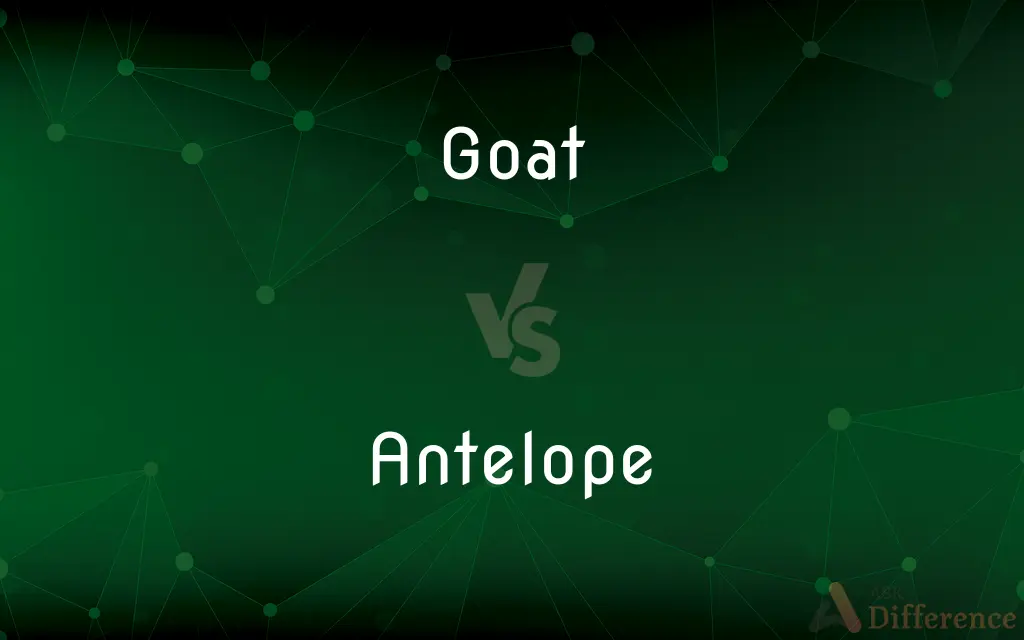Goat vs. Antelope — What's the Difference?
By Urooj Arif & Maham Liaqat — Updated on March 27, 2024
Goats are domesticated ruminants known for their adaptability and utility in farming, whereas antelopes are wild, primarily African ungulates noted for their speed and agility.

Difference Between Goat and Antelope
Table of Contents
ADVERTISEMENT
Key Differences
Goats, part of the Bovidae family, are domesticated animals kept for their milk, meat, fur, and skin across various cultures worldwide. In contrast, antelopes, which also belong to the Bovidae family, are wild animals found mainly in Africa, as well as parts of Asia and North America, renowned for their speed and elegance.
While goats are versatile, capable of living in varied climates and terrains, from mountains to plains, antelopes are typically more specialized, with different species adapted to diverse ecosystems such as savannahs, forests, and deserts. Goats have a closer relationship with humans, having been domesticated thousands of years ago, while antelopes remain primarily wild, with some species facing threats from habitat loss and hunting.
The physical characteristics of goats include shorter, often curved horns, and a beard in both males and females. Antelopes, on the other hand, display a wider range of horn shapes and sizes, often long and spiraled, which are usually more pronounced in males. Goats are known for their curious and intelligent nature, making them easy to train and manage on farms, whereas antelopes are more known for their alertness and agility, crucial for evading predators in the wild.
Goats play a significant role in agriculture and rural economies, providing resources such as dairy products, meat, and leather. Antelopes, while not domesticated, contribute to biodiversity and are important in their natural habitats for maintaining the balance within ecosystems. They also hold cultural and economic value in terms of wildlife tourism and conservation efforts.
Comparison Chart
Classification
Domesticated animal, Bovidae family
Wild animal, Bovidae family
ADVERTISEMENT
Habitat
Varied, adaptable to many environments
Mainly savannahs, forests, deserts in Africa, Asia, North America
Human Interaction
Domesticated for agriculture (milk, meat, fur)
Wild, with some conservation in reserves
Physical Traits
Shorter curved horns, beards, sturdy build
Longer, often spiral horns, slender build
Behavior
Curious, intelligent, easily trainable
Alert, agile, adapted to evade predators
Role
Agriculture, dairy/meat production, pets
Biodiversity, ecosystem balance, wildlife tourism
Compare with Definitions
Goat
A domesticated ruminant animal kept for its milk, meat, fur, and as pets.
The farmer expanded his herd with several new goats for milk production.
Antelope
A member of a number of even-toed ungulate species indigenous to various regions in Africa and Eurasia.
The graceful antelope grazed on the savannah, alert to any signs of predators.
Goat
Known for their social, curious nature.
Goats often form close bonds with each other and can be quite playful.
Antelope
Many species are endangered due to habitat loss and hunting.
The conservation efforts for the endangered antelope species focus on habitat preservation and anti-poaching measures.
Goat
Can thrive in various environments, from mountains to plains.
Goats are known for their ability to graze almost anywhere, even in sparse, rocky areas.
Antelope
Symbolizes grace and beauty; significant for ecotourism.
Antelopes are a popular draw for tourists on safari, contributing to conservation funding and local economies.
Goat
Essential for small-scale and sustainable farming.
In many rural areas, goats provide a vital source of income through dairy and meat.
Antelope
Lives in habitats ranging from dense forests to open plains.
Different antelope species have adapted to survive in specific environments, from arid deserts to wetlands.
Goat
Used for milk, meat, and fiber production.
Besides dairy and meat, some goat breeds are prized for their luxurious mohair.
Antelope
Developed for speed and agility to evade predators.
The antelope's slender build and long legs are perfectly adapted for swift escapes from predators.
Goat
The domestic goat or simply goat (Capra aegagrus hircus) is a subspecies of C. aegagrus domesticated from the wild goat of Southwest Asia and Eastern Europe. The goat is a member of the animal family Bovidae and the subfamily Caprinae, meaning it is closely related to the sheep.
Antelope
The term antelope is used to refer to many species of even-toed ruminant that are indigenous to various regions in Africa and Eurasia. Antelope comprise a wastebasket taxon (miscellaneous group) within the family Bovidae, encompassing all Old World ruminants that are not bovines, sheep, goats, deer, or giraffes.
Goat
A hardy domesticated ruminant mammal that has backward-curving horns and (in the male) a beard. It is kept for its milk and meat, and noted for its lively behaviour.
Antelope
A swift-running deerlike ruminant with smooth hair and upward-pointing horns, of a group native to Africa and Asia that includes the gazelles, impala, gnus, and elands.
Goat
A lecherous man.
Antelope
Any of various swift-running ruminant mammals of the family Bovidae, native to Africa and Eurasia and having unbranched horns.
Goat
A stupid person; a fool
Just for once, stop acting the goat
Antelope
A pronghorn.
Goat
A scapegoat.
Antelope
Leather made from antelope hide.
Goat
A domesticated ruminant mammal (Capra hircus) having backward curving horns and a beard especially in the male, raised for its wool, milk, and meat.
Antelope
Any of several African mammals of the family Bovidae distinguished by hollow horns, which, unlike deer, they do not shed.
Goat
Any of various wild ruminant mammals of the genus Capra and related genera, including the ibexes and the wild goat (C. aegagrus) of Eurasia.
Antelope
(US) The pronghorn, Antilocapra americana.
Goat
A lecherous man.
Antelope
A fierce legendary creature said to live on the banks of the Euphrates, having long serrated horns and being hard to catch.
Goat
A person who is blamed for a failure or misfortune, especially a scapegoat.
Antelope
One of a group of ruminant quadrupeds, intermediate between the deer and the goat. The horns are usually annulated, or ringed. There are many species in Africa and Asia.
The antelope and wolf both fierce and fell.
Goat
See Capricorn.
Antelope
Graceful Old World ruminant with long legs and horns directed upward and backward; includes gazelles; springboks; impalas; addax; gerenuks; blackbucks; dik-diks
Goat
See Capricornus.
Goat
A mammal, Capra aegagrus hircus, and similar species of the genus Capra.
Goat
(uncountable) The meat of the aforementioned animal.
Ugh, we're having goat for dinner again.
Goat
(slang) A lecherous man.
Goat
(informal) A scapegoat.
Goat
(slang) A Pontiac GTO car.
Goat
(speech recognition) A person who is not easily understood by a speech recognition system; contrasted with sheep.
Goat
A fool, loser, or object of ridicule.
Goat
(roller derby) A blocker who is isolated behind the opposing team's blockers, so as to slow down the pack.
Goat
(acronym) Greatest of All Time
Goat
(transitive) To allow goats to feed on.
Goat
(transitive) To scapegoat.
Goat
To isolate (an opposing blocker) behind one's own blockers, so as to slow down the pack.
Goat
A hollow-horned ruminant of the genus Capra, of several species and varieties, esp. the domestic goat (Capra hircus), which is raised for its milk, flesh, and skin.
Goat
Any of numerous agile ruminants related to sheep but having a beard and straight horns
Goat
A victim of ridicule or pranks
Goat
(astrology) a person who is born while the sun is in Capricorn
Goat
The tenth sign of the zodiac; the sun is in this sign from about December 22 to January 19
Common Curiosities
What are the main differences between goats and antelopes?
Goats are domesticated animals raised for various agricultural purposes, while antelopes are wild animals known for their speed and are often found in African savannahs.
Why are some antelope species endangered?
Many are threatened by habitat destruction, climate change, and poaching for their meat and horns.
Can antelopes be domesticated like goats?
Antelopes are not typically domesticated due to their wild nature and the complexities associated with their care in captivity.
What roles do goats play in human societies?
Goats provide milk, meat, fiber, and leather, contributing significantly to local economies, especially in rural areas.
What is the significance of antelopes in their ecosystems?
Antelopes play a crucial role in maintaining ecological balance, serving as prey for predators and helping to manage vegetation growth.
Are there any successful conservation stories involving antelopes?
Yes, there are success stories where targeted conservation efforts have led to the recovery of certain antelope populations.
What makes goats particularly useful in sustainable farming?
Their adaptability, low maintenance, and ability to graze on sparse vegetation make them ideal for sustainable and small-scale farming practices.
How do goats adapt to different environments?
Goats are extremely adaptable, capable of surviving in harsh conditions by eating a wide variety of plants other animals cannot.
How do the physical characteristics of goats and antelopes differ?
Goats tend to have shorter, curved horns and a more robust build, while antelopes have longer, often spiraled horns and a slender, agile build.
Can antelopes be found outside of Africa?
Yes, while many species are native to Africa, antelopes are also found in Asia and parts of the Middle East.
Do goats and antelopes share any common ancestors?
Yes, both are part of the Bovidae family, sharing a common evolutionary lineage, but they have diverged significantly over time.
What is the economic impact of antelopes on tourism?
Antelopes are a major attraction in wildlife tourism, especially in Africa, contributing to conservation efforts and local economies.
How do the social behaviors of goats and antelopes compare?
Goats are known for their curiosity and social behavior, often forming close bonds within herds, while antelopes are generally more solitary or form loose herds, with a strong instinct to flee from threats.
Share Your Discovery

Previous Comparison
Polymath vs. Polyhistor
Next Comparison
Turbot vs. FlounderAuthor Spotlight
Written by
Urooj ArifUrooj is a skilled content writer at Ask Difference, known for her exceptional ability to simplify complex topics into engaging and informative content. With a passion for research and a flair for clear, concise writing, she consistently delivers articles that resonate with our diverse audience.
Co-written by
Maham Liaqat















































